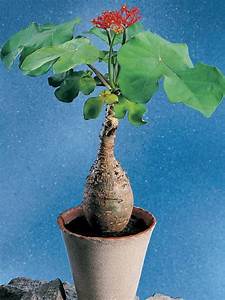This past May, when the garden club held its annual plant
sale, I was determined to come home empty handed. Well,
actually if that had been the absolute truth, I would have left my wallet at
home. As it was, I was pretty good
and brought home only a few new plants.
And since my flowerbeds were and are full to overflowing, the new ones
are now members of the horde of potted plants sitting around my yard. This, of course, means I will have to bring
them inside (along with the many, many others) come fall. I shall probably complain to high heaven
then.
When I buy plants, it is because of (1) I am already
familiar with it and want one; (2) something about the plant catches my
attention; or (3) I just like the name.
This one – I just liked the name – Buddha Belly (Jatropha podagrica) or Bottle Plant or Gout
Plant.
Yes, yes – I got two
of them
but they are slightly different
from one another
but they are slightly different
from one another
Buddha belly plants are succulents and native to dry or semi-moist
tropical climates. Ok, that’s good – it’s semi-moist here (all the damn time!). Usually they’re grown as a container plant but
in warm climates they can be planted outdoors.
In a perfect world, they can grow to upwards of 5’ tall but mostly they
get to be 2-3 feet tall. They have a
swollen lower trunk (thus the name Buddha Belly or Gout Plant), green leaves
that look similar to maple leaves, and coral colored flowers. Like many succulents, they don’t require a
great deal of maintenance. Their flowers
attract butterflies. Oh, and don’t lick
it – the sap is poisonous.
This plant likes full to partial sun (here, I’m going with partial – our full sun is HOT!!) Water plants deeply once or twice each week
and allow the soil to dry out in between waterings. Come fall, the plant will
drop its leaves and become dormant. Stop watering all together – then start up
again in the spring. Fertilize each
month during spring and summer. It can
be prone to scale and mealy bugs. If
that happens, spray with insecticidal soap, available at most garden centers or
make your own - mix 1 tablespoon of liquid dish detergent with 1 quart of water
and put the mixture in a spray bottle.
Buddha Belly is cold sensitive so you will need to protect it if planted
in the ground or bring it inside if in a container.
This is my first time to grow Buddha Belly so I’ll try to
post another picture of it one day when it’s grown up to (hopefully) look like
this.
Another of the plant
sale plants I got is Homalocladium platycladum or Ribbon Plant. I didn’t just refer to it by the common name
because there are a great big bunch of plants out there with the common name of
Ribbon Plant. It’s also called Tapeworm
Plant (ick, don’t care for that at all)
or Centipede Plant (better, but I’m going
with Ribbon).
This is a member of the Knotweed family and is from the
Solomon Islands. It is an evergreen
shrub with flat green stems and really no leaves. Well, it does make little leaves at the joint
but they turn into the flat stem. It
grows both like a shrub and a climber, has tiny, short-lived flowers that come
out in late spring, and grows really a lot depending on where it is.
It grows best in partial shade, although I did read it also
likes full sun. However, you want to
keep the soil moist and here, that’s really difficult in full sun. I’m keeping mine in bright shade. It will grow in most any soil from a sandy
loam to moderate clay. Ribbon Plant will
suffer drought poorly and will go limp and bedraggled easily. One of the facts I read says it will dieback
at the tips in drier climates so keep the humidity at least 50% (hahahahaha – oh, no problems there).
Fertilize it monthly during the growing season.
I had one of these plants long years ago. It didn’t survive the move to Colorado. I am more hopeful for the new one.
Take care







No comments:
Post a Comment